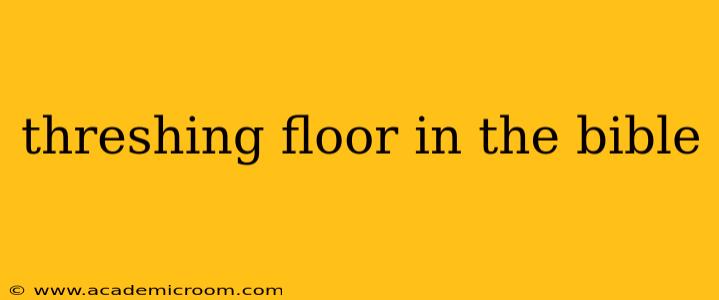The threshing floor, a seemingly mundane element of ancient agricultural life, holds significant symbolic weight in the Bible. Far from being a simple setting, it represents a place of judgment, revelation, and divine interaction. Understanding its biblical significance offers profound insights into God's character and his dealings with humanity. This exploration will delve into the various appearances of the threshing floor in scripture, examining its symbolic meaning and answering some frequently asked questions.
What is a threshing floor in the Bible?
A threshing floor in biblical times was a flat, hard-packed area, typically made of stone or clay, where farmers would separate grain from the stalks after harvesting. Animals, often oxen, would trample over the harvested grain, causing the kernels to detach. This process was crucial to food production and a vital part of daily life in ancient Israel. Its exposed nature, often located on a hilltop for better wind dispersal of chaff, made it a prominent and easily accessible location within a community.
What is the symbolic meaning of the threshing floor in the Bible?
The threshing floor's symbolic meaning transcends its agricultural function. It represents a place of:
-
Judgment: The separation of grain from chaff mirrors God's judgment of humanity, separating the righteous from the wicked. The winnowing wind, which blows away the chaff (the worthless), symbolizes God's judgment separating the good from the bad. This imagery is prominent in various Old Testament passages.
-
Revelation: The threshing floor often serves as a location for divine encounters and revelations. Key events and pronouncements occur here, emphasizing its significance as a place where God interacts with his people.
-
Preparation: The process of threshing prepares the grain for storage and consumption, mirroring God's preparation of his people for future blessings or trials.
What are some examples of threshing floors in the Bible?
Several key biblical events unfold on or near a threshing floor, strengthening its symbolic power:
-
Ruth and Boaz (Ruth 3): Ruth strategically positions herself on Boaz's threshing floor, highlighting her faith and trust in God's provision. This scene underscores the themes of redemption, provision, and divine intervention within a context linked to agricultural processes.
-
Araunah's threshing floor (2 Samuel 24; 1 Chronicles 21): God instructs David to build an altar on Araunah's threshing floor, emphasizing its sanctity and suitability for a divine presence. This act underscores the themes of sacrifice, atonement, and God's presence residing among his people.
-
The threshing floor and the coming of the Lord (Joel 3): The threshing floor features prominently in the prophecy of Joel, depicting it as a stage for the Lord's final judgment and the gathering of nations. This highlights the prophetic significance of the threshing floor and alludes to the culmination of human history before God’s judgment.
Why is the threshing floor significant in biblical prophecy?
The threshing floor's recurring appearance in prophecy underscores its symbolic significance as a place of judgment and gathering. The imagery consistently portrays God's ultimate judgment and the separation of the righteous from the wicked. The winnowing process, so integral to the threshing floor's function, becomes a metaphor for God's meticulous discernment and ultimate justice.
What does the threshing floor represent in Revelation?
While not explicitly mentioned in the Book of Revelation, the underlying symbolism of judgment and separation resonates with the themes presented. The imagery of the threshing floor can be seen as a precursor to the final judgment scenes depicted in Revelation, where the righteous and the wicked are ultimately separated.
Conclusion:
The threshing floor in the Bible is far more than a simple agricultural setting; it's a powerful symbol representing God's judgment, revelation, and interaction with humanity. Its significance is woven throughout the narrative, from Ruth's hopeful encounter to David's act of atonement and the prophetic pronouncements of Joel. Understanding its symbolic meaning enriches our understanding of biblical narratives and provides profound insights into God's character and plans for humanity.
